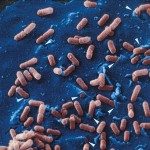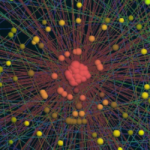Link to Pubmed [PMID] – 25991686
MBio 2015;6(3):e00598-15
UNLABELLED: Listeria monocytogenes enters nonphagocytic cells by a receptor-mediated mechanism that is dependent on a clathrin-based molecular machinery and actin rearrangements. Bacterial intra- and intercellular movements are also actin dependent and rely on the actin nucleating Arp2/3 complex, which is activated by host-derived nucleation-promoting factors downstream of the cell receptor Met during entry and by the bacterial nucleation-promoting factor ActA during comet tail formation. By genome-wide small interfering RNA (siRNA) screening for host factors involved in bacterial infection, we identified diverse cellular signaling networks and protein complexes that support or limit these processes. In addition, we could precise previously described molecular pathways involved in Listeria invasion. In particular our results show that the requirements for actin nucleators during Listeria entry and actin comet tail formation are different. Knockdown of several actin nucleators, including SPIRE2, reduced bacterial invasion while not affecting the generation of comet tails. Most interestingly, we observed that in contrast to our expectations, not all of the seven subunits of the Arp2/3 complex are required for Listeria entry into cells or actin tail formation and that the subunit requirements for each of these processes differ, highlighting a previously unsuspected versatility in Arp2/3 complex composition and function.
IMPORTANCE: Listeria is a bacterial pathogen that induces its internalization within the cytoplasm of human cells and has been used for decades as a major molecular tool to manipulate cells in order to explore and discover cellular functions. We have inactivated individually, for the first time in epithelial cells, all the genes of the human genome to investigate whether each gene modifies positively or negatively the Listeria infectious process. We identified novel signaling cascades that have never been associated with Listeria infection. We have also revisited the role of the molecular complex Arp2/3 involved in the polymerization of the actin cytoskeleton, which was shown previously to be required for Listeria entry and movement inside host cells, and we demonstrate that contrary to the general dogma, some subunits of the complex are dispensable for both Listeria entry and bacterial movement.



